The exotic and invasive flora of Portugal - Universidade de Coimbra
The exotic and invasive flora of Portugal - Universidade de Coimbra
The exotic and invasive flora of Portugal - Universidade de Coimbra
Create successful ePaper yourself
Turn your PDF publications into a flip-book with our unique Google optimized e-Paper software.
J. Domingues <strong>de</strong> Almeida & H. Freitas <strong>The</strong> <strong>exotic</strong> <strong>and</strong> <strong>invasive</strong> <strong>flora</strong> <strong>of</strong> <strong>Portugal</strong><br />
Province<br />
Table 6<br />
<strong>The</strong> distribution <strong>of</strong> <strong>exotic</strong> naturalised plant species according<br />
to the Portuguese provinces<br />
Minho<br />
Trás-os-Montes e Alto Douro<br />
Douro Litoral<br />
Beira Litoral<br />
Beira Alta<br />
Beira Baixa<br />
Estremadura<br />
Ribatejo<br />
Alto Alentejo<br />
Baixo Alentejo<br />
Algarve<br />
Province’s<br />
abbreviature<br />
Mi<br />
TM<br />
DL<br />
BL<br />
BA<br />
BB<br />
E<br />
R<br />
AAl<br />
BAl<br />
Ag<br />
Province’s<br />
surface (km 2 )<br />
4 889<br />
11 965<br />
3 363<br />
7 693<br />
9 521<br />
7 409<br />
* 5 238<br />
7 294<br />
12 618<br />
13 751<br />
4 960<br />
N.º <strong>of</strong> alien<br />
species<br />
155<br />
158<br />
216<br />
262<br />
92<br />
83<br />
314<br />
134<br />
139<br />
160<br />
138<br />
For a map <strong>of</strong> Portuga1 with the province's boundaries, see Castroviejo & al. (1986-2000).<br />
% <strong>of</strong> total <strong>of</strong> alien<br />
species<br />
31.0<br />
31.6<br />
43.2<br />
52.4<br />
18.4<br />
16.6<br />
62.8<br />
26.8<br />
27.8<br />
32.0<br />
27.6<br />
Alentejo. Fortunately, these two provinces are still not largely affected by <strong>invasive</strong><br />
species with 31.6 <strong>and</strong> 27.8 % <strong>of</strong> the national total <strong>of</strong> <strong>exotic</strong> species, respectively.<br />
This might be explained by their isolation <strong>and</strong> low human population pressure. <strong>The</strong><br />
provinces with the lower number <strong>of</strong> <strong>exotic</strong> naturalised species are Beira Baixa, with<br />
83 species, or 16.6 %, <strong>and</strong> Beira Alta, with 92, or 18.4 % <strong>of</strong> the total number. Baixo<br />
A1entejo, Minho, Algarve <strong>and</strong> Ribatejo are provinces placed in an intermediate<br />
position. <strong>The</strong> number <strong>of</strong> <strong>exotic</strong> species in these provinces ranges between 138<br />
<strong>and</strong> 160.<br />
<strong>The</strong> accumulation/recognition <strong>of</strong> the number <strong>of</strong> taxa <strong>of</strong> <strong>exotic</strong> natura1ised<br />
plants during the last centuries is found in Table 7. <strong>The</strong> data in this table are accumulated,<br />
thus not consi<strong>de</strong>ring the extinctions which had already occurred.<br />
As usual, 1500 is the date chosen for starting point <strong>and</strong> the recording <strong>of</strong> 11 archeophytes<br />
is consi<strong>de</strong>red. <strong>The</strong> second half <strong>of</strong> the 19th century <strong>and</strong> the beginning <strong>of</strong><br />
the 20th century are also singular due to the <strong>de</strong>velopment <strong>of</strong> railways, which greatly<br />
contributed to the expansion <strong>of</strong> <strong>exotic</strong> <strong>flora</strong>. Also very significant was the intensification<br />
<strong>of</strong> gar<strong>de</strong>ning, with the introduction <strong>of</strong> many <strong>exotic</strong> ornamental species;<br />
some <strong>of</strong> which escaped from cultivation <strong>and</strong> eventually became naturalised.<br />
From 1945 till present, the number <strong>of</strong> new introduced species known raised<br />
even more. Human population growth, industrialization, mo<strong>de</strong>rnization <strong>of</strong> agriculture<br />
-frequently with the introduction <strong>of</strong> <strong>exotic</strong> seeds, which bring together other<br />
un<strong>de</strong>sired seeds-, <strong>de</strong>velopment <strong>of</strong> transport <strong>and</strong> intensification <strong>of</strong> transportation<br />
are responsible for the increase <strong>of</strong> <strong>exotic</strong> plants. During the last <strong>de</strong>ca<strong>de</strong>s, a<br />
great number <strong>of</strong> new alien species, more or less naturalised, have been found <strong>and</strong><br />
i<strong>de</strong>ntified by many authors.<br />
Botanica Comp1utensis<br />
2001,25,317-327<br />
324



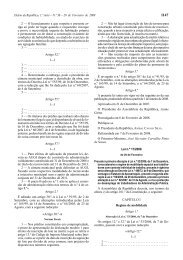
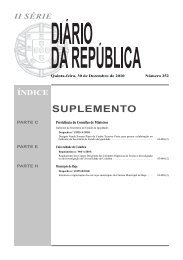
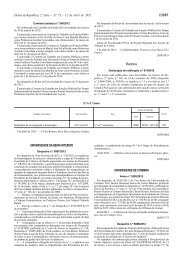
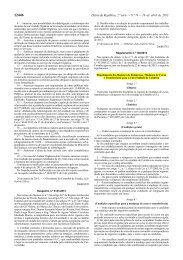
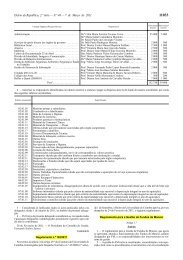
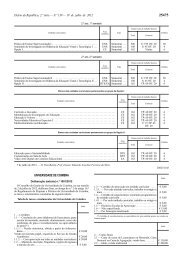
![RL #35 [quadrimestral. Julho 2012] - Universidade de Coimbra](https://img.yumpu.com/27430063/1/190x234/rl-35-quadrimestral-julho-2012-universidade-de-coimbra.jpg?quality=85)
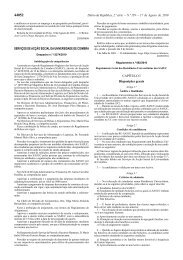
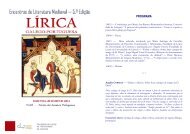
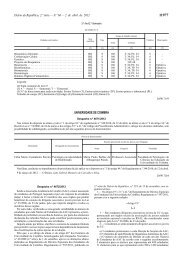
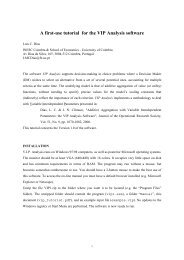
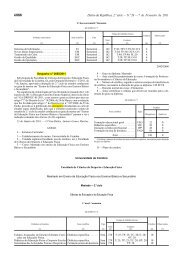

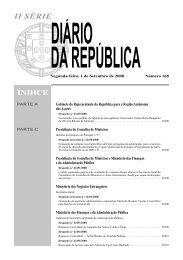
![RL #34 [quadrimestral. Março 2012] - Universidade de Coimbra](https://img.yumpu.com/27430022/1/190x234/rl-34-quadrimestral-marao-2012-universidade-de-coimbra.jpg?quality=85)